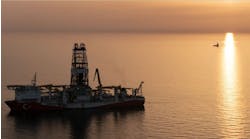David Shields
Correspondent
Petroleos Mexicanos' Exploration and Production division, known as PEP, has big plans for 2003-2006. A provisional works program includes acquiring at least 45,000 sq km of 3D seismic, 10,000 km of 2D seismic, and drilling 10 to 12 wells.
The state-run company plans to evaluate hydrocarbon potential and incorporate deepwater reserves in the Mexican GoM. PEP has gathered information from deepwater areas to over 1,600-ft water depths. Data includes satellite gravimetry and aerial magnetometry from the whole Mex-ican GoM, geochemical sampling, 35,000 km of 2D seismic, and 4,000 sq km of 3D seismic.
Evaluating opportunities
According to PEP General Director Luis Ram-irez Corzo, data interpretation has allowed Pemex to define the tectonic framework in terms of regions and to draw up an inventory of 190 deep-water exploratory opportunities. PEP estimates a prospective resource base of 22 Bboe of crude.
There have been conflicting reports about what PEP might do in deepwater. One version is that it would get its feet wet first in up to 2,000 ft depths off southeastern Mexico. Another says PEP might venture into the Perdido fold belt. In any case, Ramirez Corzo said, PEP would want to talk to oil majors about putting together a Mex-ican deepwater project through joint ventures. "However, we would need changes in our hydrocarbon laws even to think of such ventures. The law just does not allow us to do it at this point," he said.
That might change, though, as Mexicans realize the need to open up new frontiers as a way of increasing oil output in the coming years.
If it were not for the legal drawback, "we could be thinking about producing 1 MMb/d in Mexican deepwater within five or six years," he added. "However, current laws restrict us in practice to onshore and shallow water operations where the best we can do is reach output of 4 MMb/d a few years from now and maintain that level."
Setting the stage for foreign investment
PEP recognizes that it cannot go it alone in deepwater. "We would need a joint venture with global majors who have developed the technology. We would be interested in the Perdido fold belt because there are companies with discoveries there on the US side, and we know that the geological trends continue and are even more proliferous on the Mexican side."
Ramirez Corzo is well aware that global oil companies would need some kind of risk- or production-sharing concessions to get involved in Mexican deepwater. However, this is still a political taboo in Mexico.
"Ideally, our government would have all kinds of contracts – multiple service contracts (MSC), concessions, risk contracts, or other agreements – at its disposition and be able to judge what suits the nation's interest best in terms of profitability, but laws currently exclude private operators from any kind of oil production," Ramirez Corzo said.
In the case of the Perdido fold belt, "companies like Unocal and Shell are already building the underwater infrastructure in projects like Trident, Great White, and Baha that we might be able to use for handling any oil production we might eventually have in the area," he said. If the infrastructure on the US side of the maritime boundary could be used to export the Mexican oil, the project would be more cost-attractive.
PEP is known to have entered into technical agreements with several majors for advice on deepwater exploration, but companies cannot expect anything better than contracts on a fee-for-service basis in the Mexican oil patch without constitutional and legal framework changes.
Cantarell and other projects
For now, PEP's prospects are to produce 4 MMb/d in 2006. The super giant Cantarell field will be the mainstay for several years, with recent production having reached 2.1 MMb/d and potentially rising to 2.4 MMb/d. The Mexican government has set an output goal of 3.55 MMb/d and 4.7 bcf/d for 2003, a year in which output from Cantarell is expected to peak. These figures compare to 3.17 MMb/d and 4.4 Bcf/d for the first nine months of 2002.
Over the next two or three years, output should increase from the heavy-oil Ku-Maloob-Zaap complex just beyond Cantarell in Campeche Bay and should get underway in earnest on the light-crude oil fields in the Tabasco Littoral. Ku-Zaap-Maloob currently produces about 200,000 b/d and is expected to produce over 700,000 b/d later in the decade. This complex will require $3.7 billion in investments over 18 years, according to company plans. A secondary recovery project is proposed for the Abkatun-Pol-Chuc offshore complex in Campeche Bay, which produces light crude oil, but has declined severely in recent years.
"We will be trying to maintain our investment levels in E&P at $8-$10 billion annually in the long term so as to strengthen our reserve portfolio. This is equivalent to $7 billion in direct physical investment and $3 billion for interest payments on debt. This would put us on a similar investment level to Shell, BP, and Exxon," said Ramirez Corzo.
Facing new frontiers
The company's oil reserves have fallen mark-edly in recent years; exploration is suddenly a major priority again.
"One of our goals is to evaluate the country's oil and gas potential. We will be spending about $500 million over the next four years or so on shooting seismic through service contracts," Ramirez Corzo said. This investment would also allow PEP to open up frontier exploration for the first time in 25 years.
"We have a great many exploration opportunities that have gone untouched all along the continental shelf and in deepwater. By evaluating potential, we can define clear objectives and get the most out of our investments. The only thing we have been doing for the past two decades is exploring close to reserves we have already discovered," he said.
Another recently announced success at PEP is the Lankahuasa nonassociated gas field in shallow waters off the Veracruz coast. The company has already certified 3 tcf of possible reserves through its first successful exploratory well and expects current drilling to provide more. There is also optimism about Lankahuasa deepwater prospects.
An additional emerging offshore priority is the Coatzacoalcos project off southeastern Mexico. The 13,000-sq-km area lies in water depths to 1,600 ft. PEP has begun exploration to confirm prospects, spending $100 million in 2002. Investments will reach $300 million in 2003.
"This is a high priority project for us, not only because of the quantity and quality of reserves we think we can find, but because of the proximity of strategic infrastructure and producing fields onshore," Ramirez Corzo said.


